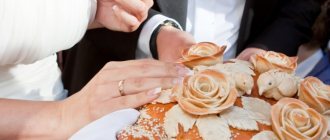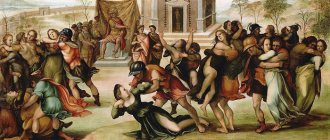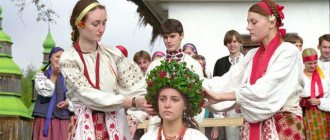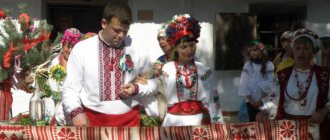The role of rituals
Each culture has its own individual holidays, but in almost all of them a wedding is celebrated. Marriage traditions began to emerge in every nation even when it was just being formed, so countless variations have survived to this day. Find out more about Russian traditions.
Such customs form the invisible framework of the wedding scenario. Even if the bride and groom do not realize it, many of their actions are also a kind of tradition. A white wedding dress, a ransom, a wedding procession, an exchange of rings, a kiss that seals the marriage - all this has passed through the centuries, only minor details change.
Following traditions does not mean that the wedding will be the same as everyone else's. Now there is a tendency to either hold a wedding in a Western style, or completely abandon any customs in favor of a calm celebration in the family circle. Those couples who observe the long-standing traditions of their people at their wedding always look more original and natural.
Interesting!
The role of baking at the holiday
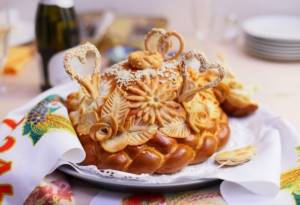
Nowadays it is customary to treat wedding guests to a large and richly decorated cake, but in the past homemade cakes of all shapes and sizes were popular. The newlyweds themselves were also treated to a culinary masterpiece from the oven - a round, large loaf of bread, shining in the light, with patterns in the form of an ethnic ornament. Each element of such a design was carefully thought out and had a symbolic meaning:
- braids and weaving - sealing the destinies of the newlyweds and their future children into one common one;
- viburnum and roses - a wish for mutual love and respect;
- two swans - a symbol of the newlyweds themselves, who swore eternal fidelity to each other;
- grapes are a symbol of fertility, a wish for quick, strong and healthy offspring.
The loaf itself is unsweetened white bread, most often round in shape, since it symbolizes the sun. This wedding pastry represents the unity of two hearts, as well as fertility, prosperity and prosperity . It was with the loaf that the wedding feast began, and the salt served with it symbolized a comfortable life.
The wedding celebration begins with the meeting of the newlyweds with a loaf and the words of the parents. The newlyweds, after the official wedding ceremony, must break off or bite off a piece of this traditional wedding pastry. It is believed that the one who has more will be the head of the family. You can do with the rest of the loaf at your discretion: give it to guests, take it home with you to eat whole or dry.
In another variation of this tradition, the bride and groom break off a piece of baked goods, sprinkle it with salt and feed it to each other. It is believed that at this moment they can “annoy” each other for the last time, and after that they should live in harmony and peace. After this, the salt can be poured into a fabric bag to keep as a keepsake.
What to say?
- It is better if parents adhere to a specific plan. A well-thought-out script will prevent awkward moments.
- Despite the fact that the congratulations should be short, you should not skimp on words. The bride will be pleased to hear gentle, kind words of approval and support.
For newlyweds, the wedding day is a very important one; they experience a lot of emotions. The task of parents is to help, support and be there. Correctly chosen words evoke pleasant and tender feelings; they remain in memory for many years.
Meeting the newlyweds with a loaf of toast, the words of the toastmaster in verse at the wedding.
The meeting of the bride and groom after registration with a loaf and salt is an ancient wedding ritual that came to us from our ancestors and has been preserved almost in its original form.
A Slavic wedding was never complete without a meeting with a loaf of newlyweds who arrived from the church after the wedding. The newlyweds were greeted on the threshold of the groom's parents' house by the father and mother of the young spouse. The groom's father held an icon, which was used to bless the newlyweds for a happy life together, and the mother held a loaf of bread and a salt shaker. The young people bowed to their parents, accepted their blessing and kissed their father and mother three times in turn. Since the newlyweds most often went to live with their husband’s parents, the meeting with bread and salt was conducted by the owners of the house. Nowadays, young people do not always go to live with their husband’s parents. In this regard, at some weddings, the loaf is held not only by the mother of the groom, but also by the mother of the bride.
The ruddy loaf is not held with bare hands, but always on a beautifully embroidered new towel. A depression is made in the middle of the loaf, and a salt shaker with salt is placed. According to tradition, the young must break off or bite off a piece of the loaf. Whoever breaks off or bites off a larger piece will dominate the family. The broken pieces are dipped in salt. The groom gives his broken piece of salt to the bride to try with his hand, and the bride gives it to the groom. This symbolizes the joint overcoming of troubles and sorrows that arise in a young family. After exchanging salty pieces, the couple takes a sip of champagne or wine from a glass, which can then be broken for good luck.
Speech on a loaf at a wedding.
Mom, holding a loaf of bread, gives a parting speech to the young couple. There is no point in saying too long a parting word, since the guests and newlyweds have been on their feet for a long time and everyone is eager to sit down at the banquet tables. You can prepare words in poetic form in advance, or you can say them yourself. If you think through or learn the words before the wedding, you will feel more confident and the ceremony will go smoothly.
The meaning of a speech on a loaf at a wedding is to wish a happy family life, strong relationships and a cloudless life path that the young people now have to go through hand in hand.
We offer you several options for speeches for a loaf at a wedding.
“Our dears, happiness and strong love to you for many years to come! Let the years pass, but your hearts will remain reverent towards each other. Let the doors of your home always be open for guests and family, let your table be bursting with dishes, and let your house be filled with the happy laughter of your children! May you live happily ever after!" “We welcome you with bread, salt and parental love, so that you will always be together for many years!”
If both mothers are holding the loaf, you can say the following poetic speech:
Mother of the bride: “We want to treat you to some difficult bread and bless you with parting words.” Mother of the groom: “We hand over the shrine to our daughter and son so that you can break off a piece for yourself.” Take a bite, son. Mother of the bride: “You try too, daughter.” Let this loaf be the key to health! The key to happy and joyful years! Mother of the groom: - You will now be your beloved daughter-in-law, (name of the bride). Many victories await you, (name of the groom)! Mother of the bride: - Appreciate each other, and honor us. Raise your kids without any hassle. Mother of the groom: “And may this piece of holy loaf bless you and lead you to happiness!”
At the end of the parting speech and all actions with the loaf, the young people are blessed with an icon. After the blessing, the newlyweds and after them all the guests go to the hall where the wedding banquet will take place. The loaf must be broken into pieces and distributed to all guests present.
The words of the meeting of the newlyweds with a loaf at the wedding and the origins of this ancient tradition.
A wedding is a magnificent celebration, rich in a variety of customs and beliefs. One of the favorite ancient wedding rituals that has survived to this day is the meeting of the newlyweds with a loaf of bread. What words need to be spoken at this moment? How to organize it? And what is the essence of the ritual? Let's look at it below.
Features of the tradition
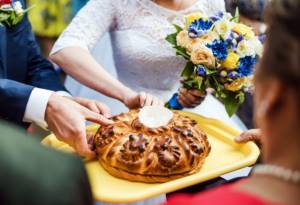
The wedding loaf was always baked in the groom's family, and this particular task went to a married relative who was happily married and had several healthy children. If the mother matched the description, then she took upon herself the responsibility of making a wedding masterpiece. Widows, single or childless relatives were not allowed to participate in this important stage, since it was believed that they could pass on some of their troubles to the newlyweds. While kneading the dough, the woman sang cheerful songs about love, happiness and peace, and when the bread went into the oven, she read prayers over it.
Sometimes the groom's male relatives also got to take part in making the loaf. When the dough was ready, a happily married man with numerous and strong offspring sent it to the oven, and then the woman came to the fore again.
Who holds the loaf when the newlyweds meet? The ceremony of meeting the newlyweds with a loaf of bread after the wedding was organized by the groom’s parents. His mother held a loaf of bread in her hands on a rushnik (towel) specially embroidered for this day. Most often, the decoration of this accessory was entrusted to the bride during preparations for the wedding, and the pattern could be made in any way. Doves were often depicted as a symbol of love, or roosters as the personification of the beginning of a new life for the newlyweds.
Previously, the meeting of the newlyweds with a loaf of bread after the wedding took place on the threshold of the house of the groom's parents, since it was there that the married couple was to settle. This is also due to the fact that the making of baked goods was entrusted to the family by the newlywed. Nowadays, newlyweds in most cases, after the official wedding, go to a banquet, and do not live with their parents at all, so the parents of the newlyweds meet them with a loaf, as a rule, at the entrance to a cafe or restaurant.
Guests also take part in this tradition: they form a kind of living corridor, standing on both sides of the road to the doors of the establishment, and shower the newlyweds with millet, oats, rice, coins, sweets or flower petals. This is how friends and relatives wish the newly-made spouses happiness and prosperity in the family.
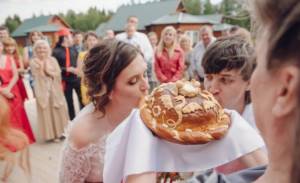
The words of the mother-in-law when meeting the newlyweds with a loaf of bread must be prepared in advance, since the congratulatory speech must be coherent and come from the heart. It is not forbidden to read the text as written, but it will look more impressive if it is memorized.
Other parents also have their roles in this tradition. The mother of the bride holds two glasses of champagne or a soft drink in her hands. After the newlyweds try the loaf, they empty their glasses and break them, throwing them over their left shoulder for good luck. The mother-in-law can also accompany this process with words of congratulations.
The words of the bride's mother for meeting the newlyweds with a loaf can also be prepared in advance. The groom's father usually holds an apple on a tray so that the newlyweds can snack on champagne, and the bride's father holds an icon for blessing.
Meeting the newlyweds with a loaf of bread
The meeting of newlyweds with a loaf of bread has deep roots. According to historians, the modern custom originates from pagan times. In those days, young people were led around a bowl in which the family placed dough for baking bread. A freshly baked loaf was placed on the lid. After the ceremony, the marriage was considered concluded.
In later times, when the wedding was held in a church, a set of a wooden bowl, a clean embroidered towel and a loaf and salt was also present in the wedding ceremony. The young people were taken around the tub immediately after church. Moreover, this responsibility was entrusted to the groom’s parents, who welcomed the daughter-in-law into the house.
By the 19th century, the custom had acquired completely modern features. The groom's parents baked a festive loaf from valuable wheat flour. In poor families or during a bad harvest, rye flour could be used. The top was always decorated with dough figures - spikelets, pairs of doves. With this loaf, placed on a towel, the newlyweds were greeted on the threshold of the house after church. It was believed that in this way the parents of the newlywed accept his wife into the family and bless their children for a long and serene family life.
After blessing, the bread was handed to the newlyweds. After which the friend divided it - the center for the young, then a piece for the parents and closest relatives, and then it came to the guests. The rest was given to the children.
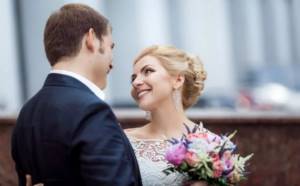
Toastmaster's speech
If the toastmaster will be present at the wedding, then he needs to accompany with comments every stage of the celebration, including the meeting of the newlyweds at the door of a cafe or restaurant.
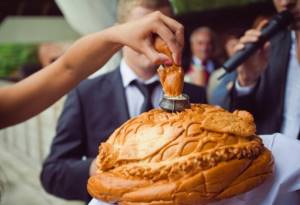
“Dear newlyweds (names of the bride and groom)! At this solemn hour, you are greeted by the people dearest to you - your parents. The groom’s mother has a delicious loaf of bread on her lovingly embroidered towel, baked as a symbol of love and prosperity, with the warmest feelings.
Newlyweds! Looking into each other's eyes, break off a piece of this wedding bread, salt it well and feed each other. You have a unique opportunity to annoy each other for the last time, and to the cheers of friends and relatives. And whoever gets the bigger piece will be the head and breadwinner of the family! Well done, groom (or bride), so you will have a difficult burden.”
Modern traditions of meeting young people
Today, weddings are celebrated differently. Not all young people decide to have a wedding ceremony in a church, replacing it with registration. And few people go to their parents’ house, preferring a banquet in a restaurant or outdoors. But changing the wedding scenario is not a reason to refuse to hold a meeting with all its attributes. You can appoint it on the threshold of the registry office or restaurant, and in the case of an outdoor ceremony - under a beautifully decorated arch.
If the groom's parents are not present at the wedding for some reason, they can be replaced by any close relatives: grandparents, aunts and uncles, brothers and sisters. In exceptional cases, when there are no suitable candidates on the groom’s side, you can use the help of the bride’s parents or relatives, witnesses at the wedding.
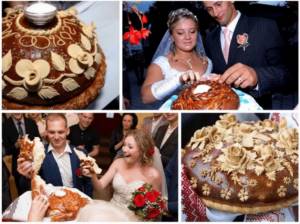
Parents' speech
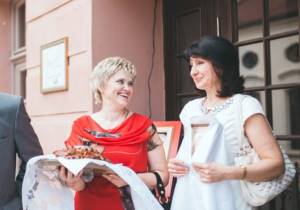
The words when the newlyweds meet with a loaf of bread mainly consist of congratulations and parting words. The mother-in-law can give her short speech in prose or poetry. It is desirable that the text comes from the heart, without pretense.
For example, congratulating the newlyweds during a meeting with a loaf of bread may look like this:
“Our dear children! We sincerely congratulate you on the starting point in your new life, on the birth of your family. I bless you for a long and happy married life, may there always be peace and order in your home!”
There is another option for the text of congratulations:
“Dear children! We are immensely glad that in this huge world your hearts found each other and merged together, and today we are all witnessing the triumph of your warm feelings for each other. Previously, I only had a son, but now I also have a wonderful daughter. I wish that harmony and mutual understanding reign in your home, so that the ringing laughter of children does not cease within the walls of your family nest. Love each other and be happy!”
You can link your congratulations directly to the loaf itself:
“Dear children! We bless you on your journey together and wish that the warmth in your hearts, like in this loaf, does not fade away, but warms you and everyone around you. May your home be full of joy, love and welcome guests. Happy holiday, my dears!”
How to meet young people without a loaf
It is not always possible to find a suitable loaf for a wedding, and the art of baking good bread is not accessible to everyone. Someone may consider the custom to be outdated, irrelevant, or breaking the whole idea of the wedding. If you decide to hold a meeting of young people without a loaf, you can use other options.
What to replace the loaf with?
You can bless the newlyweds not only with your own baked loaf. At a modern wedding, a wide variety of baked goods and culinary products are used. They are much tastier, look amazing, and go perfectly with any wedding style:
- fish and meat pies, fruit, berry, mushroom pies;
- biscuits with cream, natural jelly and glaze;
- printed gingerbread cookies in the shape of doves or hearts;
- luxurious sandwiches with caviar, meat products, herbs, vegetables;
- fruits and berries with cream;
- croissants, cakes, shortcakes.
For supporters of vegetarianism and a healthy lifestyle, we can recommend whole grain bread baked according to special recipes.

A modern encounter with champagne
A meeting of young people in a restaurant can be arranged as follows:
- after registration or wedding, the newlyweds and guests enter the restaurant’s banquet hall;
- along the way, the newlyweds are showered with flower petals, sweets or rice;
- at the end of the solemn procession, a cascade of champagne glasses awaits them;
- the newlyweds are served open bottles of champagne (or the groom opens them himself), and they pour the contents into glasses, starting from the top;
- gradually overflowing, the glasses are filled one after another.
At this time, guests applaud and give humorous recommendations, and music plays. As soon as the cascade is filled, relatives and guests approach the newlyweds, according to the established hierarchy, and, receiving a glass of champagne, wish them happiness and long years of family life.

Broadcast video
If a crowded, large wedding is planned, the problem of accommodating guests during the wedding or wedding ceremony arises. The ceremonial hall of the registry office and the church are not able to accommodate several dozen or hundreds of people, and most of the guests are forced to wait on the street or at the venue of the feast.
With modern technologies, you can find a brilliant way out of the situation: arrange a live broadcast of the ceremony on screens or quickly edit a film while the newlyweds visit memorable places in the city and arrange photo sessions. A good specialist will create a magnificent video in a matter of minutes, and all guests will be able to enjoy the colorful spectacle.
At the end of the broadcast, the newly-made spouses solemnly enter the banquet hall or any chosen place for the feast, accompanied by special effects. This could be a Mendelssohn march, any suitable music, fireworks, cold fountains, heavy smoke, a laser show.

Satin ribbons
The tradition of cutting satin ribbons has been practiced for a long time, and modern newlyweds have picked up this idea, using it in their wedding scenario. The symbolism of the action is simple: by cutting the ribbon, the newlyweds enter a new life and start a family.
Usually the ribbon is pulled at the entrance to a house or restaurant. You can use any posts or racks. To go further, the couple needs to cut the obstacle. The scissors are handed to them on a tray or pad by a trusted person - a relative, friend, parent. Cutting the ribbon, the spouses enter family life, leaving behind the carefree single years.
Ribbons can be supplemented with flags with letters or beautiful inscriptions, embroidery that form words - family, love, trust, respect and any other suitable meaning.
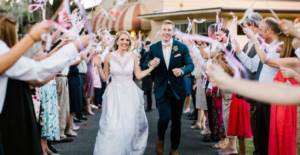
Butterflies for newlyweds
Another interesting meeting option is exotic butterflies. A box with elegant, multi-colored flyers is placed on a table or stand at the end of the path. The young people go to her to the accompaniment of solemn music and applause from the guests. The groom's parents or the host say warm words. For example, parting words: “may your journey together become as easy as the flight of butterflies.” At the end of the phrase, the box is opened and hundreds of butterflies are released to beautiful music.
Who does the baking
If desired, the groom's family can follow the old tradition and make their own wedding cakes. Of course, this process has not been accompanied by songs and prayers for a long time, but it is better to observe the condition for a happily married woman. Many people believe that baking transmits positive energy from the person who cooks it .
Now there are options that are much simpler - anyone can order a loaf of bread in a bakery or in a special store for a relatively low price. At the same time, you can be sure that the baked goods will turn out tasty and beautiful. You can make any decorations on the loaf, it all depends on the wishes of the customer. In order not to purchase an additional salt shaker, you can order a loaf with a special recess in the middle where salt is poured. You need to order the loaf in advance so that the baker can bake it on the day of the holiday. In this case, it will be fresh, soft and aromatic.
Interesting! Find out how to make, decorate and use a towel for a loaf of bread at the holiday.
Interesting video: advice from a professional toastmaster
Wedding hosts can tell from their own experience how best to observe this tradition at a wedding: meeting the newlyweds with a loaf of bread. The parents' words can be short, or you can prepare a short congratulatory speech. In this video, the meeting of the newlyweds with a loaf of bread is considered as one of the options for meeting the newlyweds at the door of the restaurant. A professional toastmaster gives recommendations on how best to welcome newlyweds after the registry office.
Additional Tips
Each stage of pre-wedding preparation has certain nuances that need to be taken into account so that everyone is satisfied. Regarding the tradition of welcoming newlyweds with a wedding loaf, the following advice is given.
- Parents are not always present at weddings in full force. If necessary, the mother-in-law can be replaced by any relative on the groom's side or by any person close to the newlyweds.
- The loaf does not replace the wedding cake, despite the fact that this pastry was previously used for the dessert part of the banquet.
What to say when young people meet with a loaf of bread? When serving a loaf of bread, it is not so important what exactly the mother-in-law says, but what matters is how she does it. Even simple words can warm the soul if they are spoken with warm feelings and intentions. You can choose a ready-made version or write the text yourself, the main thing is that it pleases the newlyweds.
Oksana Oksanovna
Wedding blogger
Previous article
Knighting: bride ransom in medieval style with an interesting scenario
Next article
Recipe: Loaf dough
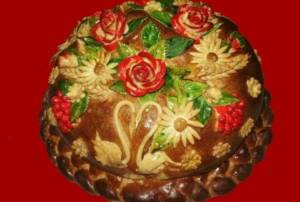
The basis for a wedding loaf is quite simple to make. Need to:
- 1 egg
- 1 glass of fat milk;
- 150 gr. creamy masta;
- half a glass of sugar;
- 0.5 teaspoons of vanillin;
- 3 cups flour;
- 10 gr. dry yeast;
- 2 tbsp. spoons of vegetable oil;
- For greasing: 1 beaten egg or 2 tbsp. spoons of warm milk with sugar;
( 3 ratings, average: 3.67 out of 5)

